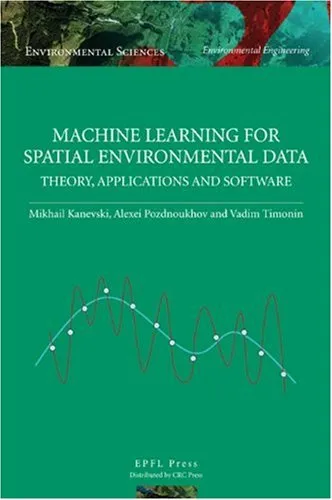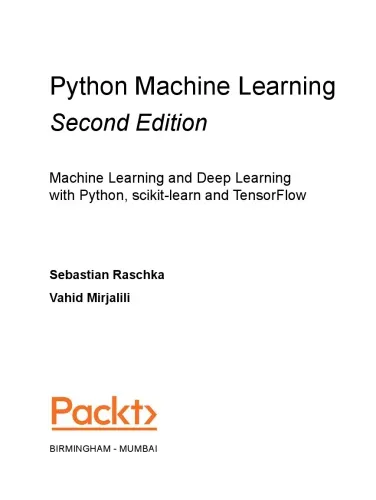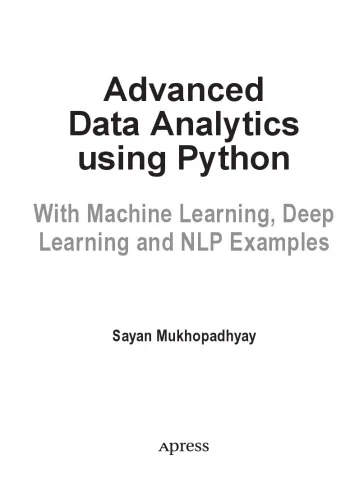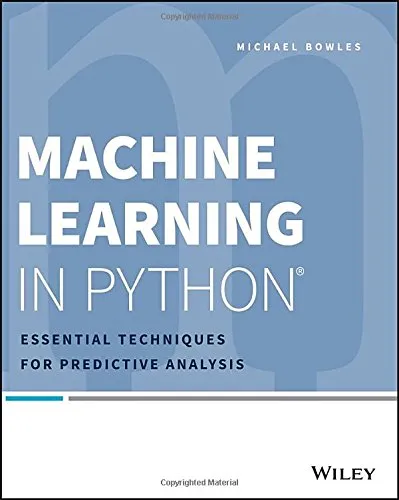Machine Learning for Spatial Environmental Data: Theory, Applications, and Software (Environmental Sciences: Environmental Engineering)
4.3
بر اساس نظر کاربران

شما میتونید سوالاتتون در باره کتاب رو از هوش مصنوعیش بعد از ورود بپرسید
هر دانلود یا پرسش از هوش مصنوعی 2 امتیاز لازم دارد، برای بدست آوردن امتیاز رایگان، به صفحه ی راهنمای امتیازات سر بزنید و یک سری کار ارزشمند انجام بدینکتاب های مرتبط:
معرفی کتاب
کتاب "Machine Learning for Spatial Environmental Data: Theory, Applications, and Software" اثر میخائیل کانوسکی، وادیم تیمونین و الکسی پوزدنوف، یک منبع جامع است که به بررسی تئوریها، کاربردها و نرمافزارهای مرتبط با دادههای محیطی فضایی با استفاده از تکنیکهای Machine Learning میپردازد. این کتاب به گونهای طراحی شده است که برای محققان، مهندسان و دانشجویان در حوزه محیط زیست و دادههای مکانی بسیار مفید باشد.
خلاصهای از کتاب
این کتاب شامل بخشهای متعددی است که هر کدام بخشی از مباحث کلیدی مربوط به Machine Learning و کاربرد آن در دادههای محیطی فضایی را پوشش میدهد. کتاب با مقدمهای بر مفاهیم پایهای Machine Learning و چگونگی کاربرد آن در تحلیل دادههای مکانی شروع میشود. سپس به بررسی الگوریتمهای مختلف از جمله supervised و unsupervised learning، و همچنین تکنیکهای پیشرفته مانند Deep Learning پرداخته میشود.
در ادامه، نویسندگان به بررسی کاربردهای عملی Machine Learning در محیط زیست، از جمله پیشبینی آلودگی هوا، تجزیه و تحلیل دادههای آب و هوا، و مطالعات تغییرات اقلیمی پرداختهاند. هر بخش از کتاب شامل مثالهای واقعی و موردی است که به خوانندگان کمک میکند تا به درک بهتری از کاربردهای مختلف این فناوری برسند.
نکات کلیدی
- درک اصول پایهای Machine Learning و کاربرد آن در دادههای مکانی.
- توانایی پیادهسازی الگوریتمهای متفاوت برای تحلیل دادههای محیطی.
- آشنایی با نرمافزارها و ابزارهای کاربردی در پردازش دادههای محیطی.
- توانایی تحلیل و پیشبینی دادههای مربوط به محیط زیست.
نقلقولهای مشهور از کتاب
ماشین لرنینگ نه تنها قدرت تحلیل دادههای بزرگ را افزایش میدهد، بلکه راهحلهای جدیدی برای مسائل محیطی ارائه میکند که پیش از این ممکن نبودند.
پیشرفت در الگوریتمهای Machine Learning به ما این امکان را میدهد که به تحلیلهای دقیقتری از تغییرات زیستمحیطی برسیم.
چرا این کتاب مهم است؟
اهمیت این کتاب در ترکیب نظریهها و کاربردهای عملی Machine Learning در علوم محیطی نهفته است. با افزایش نگرانیها در مورد تغییرات زیستمحیطی و تاثیرات آنها بر زندگی انسانها، نیاز به روشهای موثر برای تحلیل و پیشبینی این تغییرات بیش از پیش احساس میشود. این کتاب به عنوان یک راهنمای جامع، ابزارهای لازم را برای حرفهایها و محققان فراهم میکند تا بتوانند از دادههای محیطی به شکل مؤثری استفاده کنند. همچنین، با پوشش نرمافزارهای پیشرفته، به کاربران کمک میکند تا بتوانند راهحلهای نوآورانهتری برای مسائل زیستمحیطی پیدا کنند.
Introduction to Machine Learning for Spatial Environmental Data
Exploring the Intersection of Machine Learning and Environmental Science
In recent years, the exponential growth of spatial data has opened up new avenues for understanding complex environmental systems. Machine Learning for Spatial Environmental Data: Theory, Applications, and Software presents a compelling integration of up-to-date machine learning techniques with environmental sciences, offering insights into the application of data-driven methodologies in the spatial domain. Authored by Mikhail Kanevski, Vadim Timonin, and Alexi Pozdnukhov, this book provides a comprehensive approach for harnessing the power of machine learning to address environmental challenges.
Detailed Summary of the Book
The book is meticulously organized into several sections guiding readers through foundational theory, sophisticated application strategies, and practical software tools tailored for spatial environmental data. In the initial chapters, readers are introduced to the fundamental concepts of machine learning and their relevance to spatial data. The authors elucidate key techniques including regression, classification, clustering, and dimensionality reduction, applying them to geographical information systems (GIS) and remote sensing data.
As the book progresses, it delves into advanced discussions on spatial data characteristics, such as spatial autocorrelation, nonstationarity, and heterogeneity. These discussions are complemented by real-world case studies illustrating the application of machine learning algorithms to environmental monitoring, disaster risk management, and natural resource exploration. The authors provide practical guidance on leveraging open-source software and libraries, enabling practitioners to implement these techniques robustly and efficiently.
Key Takeaways
- Comprehensive understanding of how machine learning can be applied to analyze spatial and environmental data.
- Insights into addressing challenges posed by spatial data features like nonstationarity and autocorrelation.
- Experience with practical tools and open-source software for implementing machine learning solutions in environmental applications.
- Real-world case studies that bridge the gap between theory and practice in environmental science.
Famous Quotes from the Book
“A profound understanding of spatial dimensions transforms how we interpret environmental phenomena and address global environmental challenges.”
“Machine learning, with its capacity to model complex patterns and relationships, serves as a cornerstone for advancing our knowledge of the environment.”
Why This Book Matters
As environmental concerns increasingly take center stage globally, the demand for innovative solutions becomes more pressing. This book stands at the forefront of educational resources, equipping researchers, practitioners, and students with the knowledge to employ machine learning in spatial contexts effectively. By providing a blend of theory, practical applications, and software tools, the authors ensure that readers can directly impact environmental decision-making processes.
Moreover, the book fosters an interdisciplinary mindset, encouraging collaboration between computer scientists, geographers, environmentalists, and policy-makers. This approach is crucial for tackling multi-faceted issues such as climate change, resource management, and disaster mitigation. The comprehensive nature of the book makes it an invaluable asset not only for those in academia but also for professionals engaged in industry or governmental roles responsible for implementing environmental policies.
دانلود رایگان مستقیم
شما میتونید سوالاتتون در باره کتاب رو از هوش مصنوعیش بعد از ورود بپرسید
دسترسی به کتابها از طریق پلتفرمهای قانونی و کتابخانههای عمومی نه تنها از حقوق نویسندگان و ناشران حمایت میکند، بلکه به پایداری فرهنگ کتابخوانی نیز کمک میرساند. پیش از دانلود، لحظهای به بررسی این گزینهها فکر کنید.
این کتاب رو در پلتفرم های دیگه ببینید
WorldCat به شما کمک میکنه تا کتاب ها رو در کتابخانه های سراسر دنیا پیدا کنید
امتیازها، نظرات تخصصی و صحبت ها درباره کتاب را در Goodreads ببینید
کتابهای کمیاب یا دست دوم را در AbeBooks پیدا کنید و بخرید
1525
بازدید4.3
امتیاز0
نظر98%
رضایتنظرات:
4.3
بر اساس 0 نظر کاربران
Questions & Answers
Ask questions about this book or help others by answering
No questions yet. Be the first to ask!










